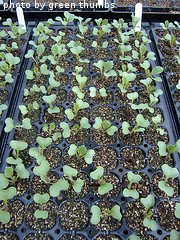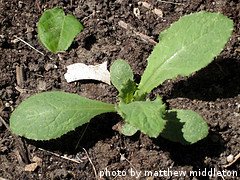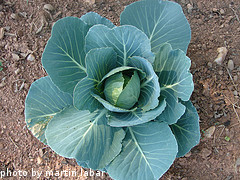Planting Cabbage
When planting cabbage, it's usually best to transplant seedlings into your garden. If you want to start with seeds, plant them indoors in small containers or flats. Once the seedlings reach 3 inches tall, they can be transplanted into your garden. You can also purchase cabbage seedlings at most garden centers.

If starting with seeds, start 7 weeks or so before the last expected frost in your area. You'll need small containers or flats, and potting soil or top soil. Fill the containers with soil, leaving 1/2 inch at the top. Drop two seeds into each container. Cover the seeds with more soil, filling the containers to the top. After planting cabbage seeds, water them in well. Keep the soil moist by watering every other day. Place the containers in a spot that gets as much sun as possible. Ideally, you want to keep the flats in an area that is at least 60-65 degrees F, although 75 degrees F is better. When the seedlings emerge and are about an inch tall, remove 1 seedling from each container and discard it, keeping the healthiest looking seedling. The cabbage seedlings will be ready for transplant when they are about 3 inches tall.
You'll want to transplant the cabbage seedlings into your garden about a month before the last expected frost in your area. Choose a location that gets lots of sun and has good drainage. The more nutrient-rich your soil is, the better. Keep in mind that you don't want to grow cabbage 2 years in a row in the same spot. So, choose a location where you haven't grown any other cabbage or brassica plants (broccoli, cauliflower, kohlrabi, etc...) in the last couple of years. Make sure the soil is well-tilled to a depth of at least 6 inches.
We typically scatter a balanced granular fertilizer in our cabbage patch a few days before we transplant our seedlings. We scatter it at a rate of about 1 pint per 100 square feet. We also add pulverized lime to our garden at the same time, because our soil is a little acidic. We water it in well and then till one last time before we set out our cabbage seedlings.

When planting cabbage seedlings, plant them deep. Using a trowel, dig holes where you want to place seedlings. Be sure to space the holes 18 inches apart. If you are planting multiple rows of cabbage, space the rows 2 feet apart. The hole should be a little wider and a few inches deeper than the size of the container. Drop some very loose soil into the bottom of the hole. Carefully remove the cabbage seedling from the container and place it upright into the hole. About half of the cabbage seedling should be below the level of the edge of the hole. Fill the hole up with loose dirt until it is level with the surface of the soil. Lightly tamp down the soil around the plant. Only about half of your cabbage seedling will be visible above the surface of the soil. After transplanting the cabbage seedlings, water them in well.
In our own garden, we grow our cabbage in raised rows. We use a shovel to create rows that are about 8 inches tall and 1 foot across for the length of the row. The raised rows helps provide drainage, breaks up the dirt a little more and makes harvesting a little bit easier, because we don't have to bend over quite so far to cut off the heads.
Although cabbage plants do well in cool weather, newly transplanted seedlings will succumb to a hard freeze. Keep a close watch on the weather in your area during the first 7-10 days after transplanting. If a hard freeze is expected, cover the plants overnight with an empty container or plastic bag. Remove the cover in the morning to allow the plant to get as much sun as possible and warm back up. After the seedlings are accustomed to the cool, outdoor weather, they will tolerate cold snaps much better.
When the plants are about 6 inches tall, a layer of mulch can be applied. This mulch will keep the soil around the plants cool and moist. Mulch will also discourage weed growth in your cabbage patch. Grass clippings, straw and chopped up leaves all work well as mulch. At the end of the growing season, these organic materials can be tilled into the soil, adding nutrients to your garden.
Now that you're done planting cabbage, it's time to think about watering and fertilizing your plants.

Click here to learn about fertilizing and watering cabbage plants
Click here to learn about harvesting cabbage
Click here for some of our favorite cabbage recipes
Click here to move from our Planting Cabbage page to our Growing Cabbage main page
Click here to go to our Home page